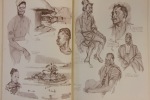Singer (Caroline) - Le Roy Baldridge (Cyrus)
White africans and black
Methodist book depot, Cape coast, Gold coast, sd (1929) 1929 In-4 cartonnage éditeur illustré de motif africains, 119 pp. Dessins en bistre in-texte et planches en couleurs hors-texte.
Reference : 20839
Bel exemplaire de cet album très séduisant. Couple choyé des cercles intellectuels de New York, lui artiste, dessinateur de presse, elle journaliste, ils voulaient s’imprégner de culture noire. Ils ont traversé l’Afrique, principalement à pied, de la Côte d’Ivoire à l'Ethiopie, vivant dans des villages indigènes, évitant tout contact avec les Européens. Bon état d’occasion
Bookseller's contact details
Librairie de l'Avenue
M. Henri Veyrier
Marché aux Puces. 31, rue Lecuyer
93400 Saint-Ouen
France
01 40 11 95 85
Payment mode




Sale conditions
Conforme aux usages de la profession. Paiement avec votre carte bancaire par Paypal ou en V.A.D. (Vente à distance sur le site), par virement ou chèque. Les frais de port sont de 9,50 € pour la France pour les colis de moins de 5kg en colissimo (ou 4,50 € en Mondial Relay), 12 € pour les pays de l'Union Européenne (sauf Espagne) en Mondial Relay. Nous consulter pour les autres pays et livres au dessus de 5kg. Notre téléphone : 01 40 11 95 85.
1 book(s) with the same title
Africans in English Caricature 1769?1819 Black Jokes White Humour.
, Brepols - Harvey Miller, 2017 Hardcover with dusjacket, 223 pages., 49 b/w ill. + 88 colour ill., 220 x 280 mm, Languages: English. ISBN 9781909400504.
Between 1769 and 1819 London experienced an unprecedented growth in the proliferation of texts and images in the popular sphere, engaging learned citizens in discussion and commentary on the most pressing social and political issues of the day. From the repeal of the Stamp Act to the French revolution, the local Westminster election or the abolition of the slave trade, these prints, political pamphlets, plays, novels and periodicals collaborated (sometimes intentionally) in critique, praise and assessment of the country?s changing socio-economic climate. African people were a critical aspect of this world of images, and their presence conveyed much about the implications of travel, colonialism and slavery on the collective psyche. Whether encountered on the streets of the city, in opulent stately homes, or in tracts describing the horrors of the slave trade, the British paid attention to Africans (consciously or not), and developed a means of expressing the impact of these encounters through images. Scholarship has begun to interrogate the presence of Africans in British art of this period, but very little has been written about their place in visual and literary humour created in a metropolitan context. This book fills this scholarly lacuna, exploring how and why satirical artists both mocked and utilized these characters as subversive comic weaponry. Dr. Temi Odumosu is an art historian, educator, and cultural strategist focussed on diversifying and transforming communications practices. Her international research and curatorial interventions have been concerned with identity politics, Black aesthetics, and the psychosocial consequences of distorted representations. Working in the spaces between archives, memory and the creative imagination, she also uses technology as a tool for activating and bringing to life history and culture in the present.
 Write to the booksellers
Write to the booksellers


